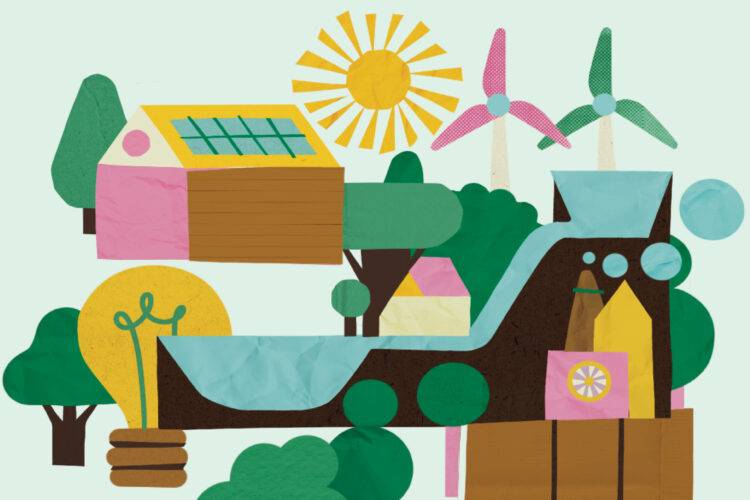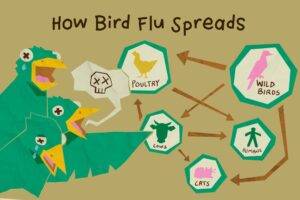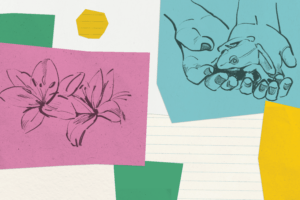
Since Donald Trump took office in January, his administration has rolled back more than 45 federal efforts to mitigate the climate crisis. From logging in national forests to ramping up oil and gas production to withdrawing from the Paris climate accord, climate science is in the political crosshairs. A 2024 study found that nearly 15% of Americans don’t believe climate change is real, and yet 2024 was the hottest year on record globally.
At the School of the Art Institute of Chicago, every undergraduate student is required to take at least six credits of natural science courses. Despite the common joke of artists pursuing art school to avoid math and science, those very things are often directly important to artists’ practices.
“As artists, I think we should be thinking a lot more about how our art impacts the environment. But as humans, I think we all need to do as much as we can to try to stop climate change and focus on saving the environment,” said SAIC student Samantha Carey (BFA 2027).
In Fall 2022, chemical oceanographer and Professor Sarah Zhou Rosengard and climate scientist and former SAIC professor Mika Tosca launched the Art and the Environment critical currents program which was a cluster of courses focused on the histories, futures, and present ecologies of the climate crisis.
Rosengard said that the school put out a call for clusters of courses that fit a particular theme to get students engaged for a brief period of time. Tosca and Rosengard proposed their curriculum centered on art and the environment, and they were given a budget and course releases to get the program started. The official program launched in the Spring of 2023 with 29 students registered.
“The environmental crises in general are real-world things. It’s not only a problem for scientists to solve,” Rosengard said, adding that scientists wouldn’t be able to solve these problems alone; major problems require different kinds of thinkers who approach crises from multiple angles.
“It’s important for students at SAIC to take classes on the environmental crises because they may learn that they actually have an active role in solving those problems,” said Rosengard. She also noted that science courses that relate to environmental issues tend to be the ones that fill the fastest.
The critical currents art and the environment program functioned the way minors at other universities operate. SAIC doesn’t have minors, so the program would not show up on a student’s degree, but students who opted in to the program would be expected to take at least two to three courses in the cluster and were given priority registration for courses centered on environmental issues. And it gave students a new community of peers working on sustainability issues.
The goal of the program, according to the proposal that was submitted to the school, was to give participating students “a fundamental understanding of global climate change and the legacies of environmental impact on marginalized communities.”
Rosengard said that a student told her they’d use the program on their cover letters when they applied to internships and jobs. “It seems like students used this program for employment purposes later in addition to their education,” she said.
These classes were not just academic science classes. Many were studio courses across a variety of disciplines including BioArt Studio, Introduction to Clay, and Scientific Illustration. Forty-five faculty members were connected to the program.
In Spring 2023, 19 courses were included in the art and environmental critical currents cluster with 52 total enrollments processed. The following semester, Fall 2023, there were 22 courses included and 55 total enrollments processed.
However, when Tosca left the school and Rosengard went on maternity leave, the program waned. The last group of students to enroll in the cluster was in Fall 2024. Enrolling in the art and environment critical current cluster is no longer an option for students.
“Without money anymore or course releases, we need to rethink how to make the program sustainable over many years, so I haven’t given up,” said Rosengard. Rosengard has hopes that the program could be reimagined and revitalized in the future, and she is currently working with Camille Martin-Thomsen, SAIC’s dean of faculty and vice president of academic affairs to shape its future.
“If you’re going to get students to enroll, it has to have many years of life, the registrar has to be on board, the deans have to be on board every semester. We need to curate the classes. It’s not that much work, but we need to somehow support that person who’s doing it, whether they’re a faculty member or someone else. There just needs to be more actors involved,” said Rosengard.
Even without the critical currents program, climate science continues to be a major theme that faculty are teaching about and students are interested in taking courses in. It’s an area various SAIC community members have been vocal about wanting the school to put more resources and attention into.
“More resources on actionable ways to be more sustainable in one’s practice would be useful to have from the school beyond just general suggestions people hear all the time, like generally being told to reuse or recycle. Things like surplus and other places where people can get repurposed material being more clearly known for everyone,” said Eros Douglass (BFA 2025).
Molecular biologist and associate adjunct professor Andrew Scarpelli teaches courses in the Art & Technology/Sound Practices department as well as in the science department. He too stressed the importance of teaching science at an arts university.
“What really sucks is that we kill off people’s curiosity in science by just siloing it. When we silo things, we lose out on a bunch of different conversations we should be having. And I think teaching science at an art school, especially if we really focus on trying to make sure that science is relevant to artists, would maybe actually be more meaningful, and it wouldn’t be so scary and daunting when people have to read a [Safety Data Sheet] because they’ve just ordered a bunch of chemicals in their studio practice,” said Scarpelli.
Scarpelli said he’s seen many clubs and groups form on campus that focus on sustainability and environmental justice, but they often aren’t long lived because there is a lack of support for them.
“It would be really nice to actually see some coursework that leads directly to people being able to participate in sustainability or sustainability initiatives. But if we do something for a year and we’re excited about it, but then forget about it or don’t support it thereafter, we’re not doing anything,” said Scarpelli.
He also touched on the idea that departments need to be more connected with one another, as there are many labs on campus that don’t know about one another’s resources and could support each other better if there was more open communication across campus.
Many universities across the country are facing significant federal funding cuts, especially to science programs and research. It’s gotten to a point where international universities, such as the Aix Marseilles University in France, are marketing to American students, calling themselves a “safe place for science.”
SAIC has the potential to make similar moves, as it is not funded by the National Science Foundation.
“Science in general, but also the field of climate studies, is being attacked right now by the Trump administration. So it might be a chance right now for us to uniquely take a stand on environmental crises, climate, and environmental justice in a way that other schools can’t do. It would be especially meaningful if we got a sustainability program off the ground in the next year. It would be communication that we’re doubling down on this using the privilege that we have,” said Rosengard.
Searching for Sustainable Science Resources?
- Lincoln Park Conservatory
Open Wednesday through Sunday at 2430 N. Cannon Drive, the Lincoln Park Conservatory has many educational programs and resources. Their EcoSteward volunteer program is focused on creating spaces for humans and nature together, and to support diverse Chicagoan wildlife.
- Urban Wildlife Information Network at the Lincoln Park Zoo
The Urban Wildlife Information Network is an alliance of educators and ecologists who are gathering and sharing data about the ways wildlife adapt to cities. Often they train local volunteers to observe different animals around Chicago, including frogs, bats, chipmunks, and coyotes. The next season of volunteering work starts this month.
- Alliance for the Great Lakes
The Great Lakes, including Lake Michigan, make up approximately 21% of the world’s natural freshwater. The Alliance for the Great Lakes keeping plastic and litter out of the lakes. They host an adopt-a-beach program where anyone can join a beach clean-up or even host one of their own through the alliance. They have been tracking over 20 years of cleanup data! The beach clean up season kicks off on Earth Day, April 22.
- Peggy Notebaert Nature Museum of the Chicago Academy of Sciences
The Peggy Notebaert has been operating for 167 years, and it holds a vast wealth of nature knowledge. Located at 2430 N. Cannon Dr. and open every day of the week, this museum has exhibits on Chicagoland birds, butterflies, marshes, and a whole center about making Illinois sustainability efforts approachable. If you’re looking for sustainability resources that are also kid-friendly, this could be a great starting place.







